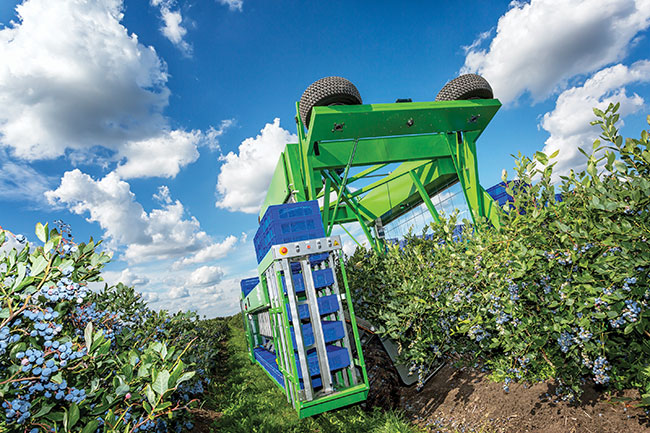
Features
Technology
Agtech and innovation: Ag robotics in reality
March 13, 2024 By Alex Barnard
 Finefield’s autonomous Harvy 500 harvester was designed for blueberries and prevents ground-drop.
Photo courtesy of Finefield.
Finefield’s autonomous Harvy 500 harvester was designed for blueberries and prevents ground-drop.
Photo courtesy of Finefield. With all of the technology implemented in modern agriculture, automation and robotics is likely the next logical leap – but it can feel like an exceptionally large one for many. Between the economic, technological, and reliability considerations, there’s the added difficulty of knowing which machine might work best for your operation, and whether it can do what it’s supposed to. Chuck Baresich, general manager of Haggerty Creek Ltd. And president of Haggerty AgRobotics in Bothwell, Ont., has been working to figure out where ag robots fit for several years. Fruit & Vegetable editor Alex Barnard spoke with Baresich about ag robotics adoption, reframing return on investment, and questions he’s often asked about ag robotics by farmers.
How did Haggery AgRobotics get started?
My brother and I are farmers in the area, and we started Haggerty Creek, the agronomy business, back in 2001. By 2004, we were involved with precision agriculture. When I got our first robot in 2020, with the price tag and the dollars involved, we thought it might be a distraction from our core business. We started Haggerty AgRobotics so that we could separate the automation piece from the agronomy side. We think it’s going to be big enough to deserve its own entity.
In 2021, we started testing the weeding robots. We didn’t really know what we were doing. Then in 2022, with the help of OMAFRA and our AgRobotics Working Group and researchers, we started to set some priorities as to where these robots actually fit into the Ontario ecosystem. And then in 2023, we made a conscious effort to deploy the majority of these robots commercially. Some of them were still placed in trials, but a lot of them were leased out to commercial farms. Figuring out where they fit is one of the big challenges.
I imagine making the robots fit in a real farm system requires some negotiation.
Farmers are very smart people. Whether it’s corn, tomatoes, onions, carrots, tobacco or any crop – farmers are very good at what they do, and they have certain cultural practices because they work. So, an engineer might have the perfect machine, but the farmer says, “What I’m doing is working pretty good. So, I you need to really show me an advantage to changing my system.”
There are some other unforeseen challenges driving the adoption. A lot of it relates to weed control. The farmers are looking at what they’re doing today and saying, “I might have two or three more years of doing it this way, but that is coming to an end. And I need to find an alternative solution.”
One issue farmers have brought up is companies creating solutions that don’t have a problem.
Sometimes engineers or developers with an idea don’t understand the time crunch the farmer is under. They don’t understand the fact that if the machine doesn’t work, the farmer doesn’t have tomorrow to make it work. Sometimes there’s a lack of understanding from the engineering side as to what the pressures are and what kind of reliability is required.
The other thing is that it’s not always just a new idea that’s required. Sometimes what the farmers are doing or the method they’re using isn’t wrong, but maybe the way they’re deploying that method can be improved. This year, we found the robotic technology might open up a different method of planting the onions that will allow for less chemical [use] while maintaining the yield. That’s really one of the sweet spots we’re trying to find, which will encourage adoption.
What’s a common question you get from growers?
One question I get asked is, “Is there a return, am I going to make any money on this machine?” The answer to that is, in some cases, yes. But you have to figure out, when you say a return on investment, what returns are you looking for? If you’re trying to compare strictly dollars of labor to dollars of robot – maybe, maybe not.
Going back to precision agriculture: the return on investment on an autosteer system in a tractor is very, very hard to measure, because technically a person can drive straight. I would argue that that return on investment is almost zero if you just measured dollars, but every tractor has one now. People have accepted that the ancillary benefits add value in a way that you can’t measure. And robotics is going to be very similar to that.
Print this page